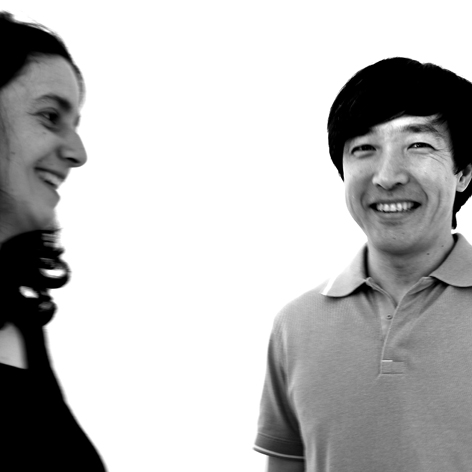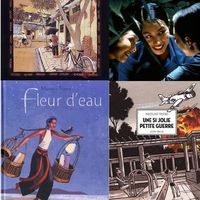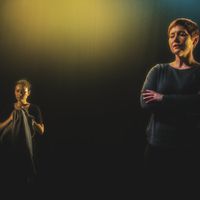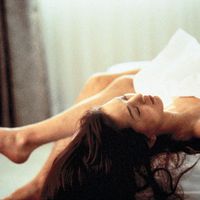Between two cultures: Euro-Asian creative personalities (part II)

In this sixth article, Magali An has focused on two design and craft projects rooted in Euro-Asian double-culture: Paris-based French-Japanese craft duo Eskimeït who creates contemporary jewelry and objects with an old Japanese coal burning technique; Vietnamese young fashion designer Linda Mai Phung who decided with entrepreneur spirit, to move to Vietnam to launch her fashion brand and work with local textile crafts.
These 2 interviews are part of a focus on creative industries and creative personalities from a Euro-Asian background. Actress, illustrator, craftsmen or fashion designer, they all have insightful personal stories. Whether they were born in Europe or Asia, whether they have chosen to live in their country of origin or decided to settle elsewhere, we discover in these interviews their artistic universe and find out how their double culture has impacted their creative lives.
Hirohiko KAMIYA & Lorène HAYAT KAMIYA - Designers - Eskimeït

Could you introduce yourselves to our readers and tell the circumstances of your meeting?
Lorene and Hirohiko: Hirohiko Kamiya, 46 years-old and Lorène Kamiya Hayat, 41, we are a French-Japanese couple and designers working together for the past twenty years.
Hirohiko: I arrived in France in 1987 to study makeup and hairstyling. I then worked in fashion, photography and theater until 1990, before starting studies at the interior design school Camondo. This is where we met.
L & H: After graduation, we have launched our own home decor collections, while freelancing in interior design on the side.
In 2004, we travelled to Japan to visit the Binchotan charcoal craftsmen from the Kishu area, which then led to our first collection of objects, lighting and jewelry with this special technique. We successfully exhibited this collection at the Maison & Objet trade show in January 2005 and 2006. Then we founded our brand called Eskimeït where we keep developing jewelry and objects around Binchotan charcoal.
Could you describe your artistic practice?
L & H: In our work - since we met- we have always been looking for new materials which we could transform and change from their original purpose and functionality. Each of our jewelry pieces is unique thanks to the organic and mineral rendering of Binchotan coal.
Even though we both have an education in design, we do not like the idea of producing objects industrially. Handcraft matters to us. As designers we still enjoy working with our hands because that's often how we get our ideas. With time we understand each other very well and collaborate in a very complementary way.
Where does your love for art comes from?
Lorene: My father was a knitwear designer and as a child, I loved making collages with wool yarn falls, knit samples, fabric scraps and manipulating materials and colors. Besides my childhood memories, I remember moments in school when I was creating things with my hands and I even remember the happy sensations I experienced in doing them.
Hirohiko: From my childhood in Japan, I've always loved making things with my hands. I remember when I was little, I used to collect the caps from milk bottles to turn them into many objects: flying UFO, car wheels over and over again. I think I have always loved making art!
You currently live in France and work as a French-Japanese design duo, how do you reconcile your two cultures in your artistic practice?
Hirohiko: Initially, I just came to Paris for my studies and what I found was a great feeling of freedom. Here in France, relationships in life and work are very different, less codified and more direct than in Japan. Sometimes, for matters of hierarchy and social status, in Japan you are not really allowed to express what you think. In Paris, interactions feel more natural and easy. However, in my work process, I feel still very much Japanese!
Lorene: Meeting each other has really opened me to completely different culture. When I went to Tokyo for the first time, I actually expected a very modern and urban city and yet I was struck by the contrast of small Shitamachi old traditional neighborhoods which are so lively. I feel more connected to the traditional side of Japan which is still very present: you can see temples everywhere. I like the idea that for Japanese people, nature is put above all and that we must protect it. I also like their idea of renewal by giving things a second life, for example with the art of Kintsugi, they would repair a broken ceramic by sealing it with a technique based on gold lacquer, which confers to this object a completely new aesthetic dimension.
What is your relationship to Japan? And how does it inspire you?
L & H: We go to Japan every couple of years. We usually visit the city of Kamakura, the ancient capital of Japan near Yokohama, for its temples and traditional neighborhoods with artisans. The Binchotan charcoal we are using is obtained by an ancestral technique dating from the Edo period. It was developed for the use of the Emperor. We use it in our designs and try to treat it in a different way, accordingly to our own perception, our environment and our two cultures.
Japan also inspires us culturally. We love Ozu films which portray so well the evolution of Japanese society with its relationships and codes. We are also inspired by Japanese landscapes, old architecture, traditional family life. All of this still lives with Japan today, through many festivals and customs. What influences us is linking modernity to tradition.
Japanese people consider their crafts as an art and not as a minor practice, what is your opinion about that?
L & H: What we like in the Japanese craftsmanship - paper, lacquer, textile, ceramics- is their real sense of aesthetics and sophistication, often coming with a hint of unexpected strangeness.
Before even starting on how to burn Binchotan charcoal, students must watch their teachers for years and understand all the senses which come into play: touching, smelling, noticing the color of the flames... In the Kishu area, we have encountered several Binchotan masters and each of them had a very personal approach from cutting the Ubamegashi oak tree branches, to manufacturing a clay oven and practicing their cooking technique. In Japan this charcoal is mainly used for its combustion and filter qualities, but there was no craft developed beyond these primary use. Yet we can't stop being amazed and inspired by the intense black color of this material, its raw beauty, its amazing hardness. It features unique shapes and patterns of woodrings and cracks, as an endless source of inspiration for our designs.
www.charcoal.eskimeit.com
Linda Mai Phung – Fashion designer
[caption id="attachment_45328" align="aligncenter" width="445"]
 Linda Mai Phung - Copyright Thai Pham[/caption]
Linda Mai Phung - Copyright Thai Pham[/caption]Could you tell us about your career path and your origins?
My name is Linda Mai Phung, I was born in France and I grew up near Paris. Both my parents are Vietnamese. I just celebrated my 30th birthday! I have studied fashion design in Paris art school Duperré. After my graduation, I have worked on various projects in fashion and graphic design in France in Paris, Europe in Prague and Berlin and finally in Ho Chi Minh City. I came to Vietnam to work for an ethical fashion brand and I never left! Coming to Vietnam made me realize that I wanted to stay and start my own ready-to-wear brand. I then launched my project in 2011. Since then, the project keeps growing. I am selling in Europe and in Asia and I have won several awards: the Eco-Fashion Designer Award by Neoplanete Magazine in 2011, the Ethical Fashion Show Creativity Prize in 2011 and the Ethical Fashion Forum Innovation Award in 2012.
Could you describe your creative work?
I am a fashion designer so I draw, design clothes and accessories, conceive seasonal women's wear collections and work on the production process with my tailors, suppliers and workshops. I draw my inspiration mostly from my many travels. One of my strongest concerns is to design sustainable products which would take in considering their impact on the environment. It is also very important to think about the people who will wear my clothes. My love for art and design has been driving me since my early childhood. Starting my own brand is actually a dream come true and an authentic passion: I really love making things, creating and designing. This is also my way of expressing my personal view of the world.
You grew up in France and chose to settle back in Vietnam. What has motivated your choice?
Vietnam is the country of my parents. So in a way, I have always had this idea of settling here, somewhere at the back of my mind. It was a project which matured through time, as a lifetime journey in a search for my family history and the development of my career.
You can find such talented craftsmen in Vietnam and the economy is booming, so I found many appeals in coming here. I decided to move to the capital city Ho-Chi-Minh City in the South and launch my fashion brand. The creative scene here is very dynamic and inspiring. The economical and urban development, the people's authenticity, the sounds, the colors, the contrasts between the city and the countryside... I enjoy all of it! And I feel that I am learning a bit more every day about myself and about the world, just by living in this exciting country.
Moving here went quite smoothly. I was pleasantly surprised by the warm welcome I received when I arrived in Vietnam. I have been very lucky, I met a lot of helpful people who have supported me in my first moments here and without whom I would never have gone this far today: the tailors, the craftsmen, my friends or even the business owner who made me come to Vietnam in the first place.
Personally I immediately felt that I belonged, thank you also to this stimulating project.
How do you work with Vietnamese ethnic minorities? And how do you combine their traditional textiles to contemporary fashion?
People do not always know that there are about fifty-four ethnic minorities spread all-over Vietnam. Most of them have their own language and their own textile techniques and traditional dresses. Each year I travel to one of these remote provinces where I have spotted certain ethnic groups with great crafts. I usually come to buy some textiles and some woven and embroidered fabrics made locally in these villages, I put them on my motorbike and then head back to Ho Chi Minh City ! Sometimes I also order custom textiles to local handicraft workshops but it is difficult in regards of my collection deadlines. The whole process requires time. For weaving, they need to grow the plants which will give the yarn- hemp for example- and in other cases, the handmade adornments such as pleating, dyeing or embroidery demand also a very long time. This is the beauty of each of these particular fabrics: they are all unique. In my designs, I now use them in the details of a hem, in a liner or a collar. I also choose major textiles to feature in my key looks which creates interesting contrasts. For example, I will use a traditional wool weaving to make a hyper contemporary biker jacket.
This illustrates well the idea of identity and origins set up in my work, by mixing materials and shapes, using an ancient embroidery lining on a garment with a very modern exterior look. This is my signature as a fashion designer.
What does double culture mean to you and does it impact your work and creative life?
My double culture is really what sets the identity of my brand: a contemporary blend of cultures, a mix of Asian and Western influences and know-how. I feel that this is an asset and a great opportunity to be able to explore different aspects of your own origins, especially in a creative field. My double culture has actually opened doors for me and it has given me an edge as a multi-cultural and travel fashion brand. I have Vietnamese roots and I grew up in France, so this was the starting point of my project. However, I am now looking to go further and define a new identity with my work, probably on a less personal note with the eyes turned towards the future.
www.lindamaiphung.com





